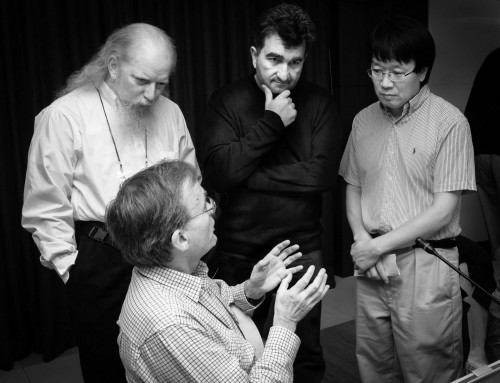Consensing — How to Boost Your Slow Deciding Company
How to Kill Your Business Easily
When it comes to decisioning in business and organisational contexts, in social communities, groups, and teams, we are entrenched to traditional consensus-based processes and methods due to our western philosophical heritage.
Consensus-based decision-making is a creative and dynamic way of reaching an agreement between all members of a group. The group is committed to finding solutions — so-called minimal viable decisions — that everyone actively supports, or at least, can live within the best interest of the whole as a team.
This contrasts to Majority Voting — aka Democratic Voting — for an item and having the majority of the group getting their way.
In consensus-based reasoning usually, the group finds this minimal viable decision by discussing and arguing equally as many alternatives as possible until all group members consent with the highest agreement to "the final" solution even if it is not the favorite of each individual.
In reality, however, often arguing deteriorates very fast more to a Debate than to a Dialogue. Heavily emotionally, the involved parties try to convince and persuade the "other" sides to adopt their own arguments and preferences. Even it is emotionless, it is a very time-consuming activity. Especially in any business contexts — when several organisational hierarchy or agreement levels — aka steering boards — are involved.
And very often this endless debating may kill the motivation and inspiration for any organisational change activities because the change driving parties debate for ages and do not come to a minimal viable decision all can agree on.
The death of any organisational change initiative is the alignment of preferences of all involved parties required by consensus-based decision-making.
To summarize, when it comes to group decision-making in organisations, the traditional methods may have dramatic side effects:
- people in the group start fighting to be heard;
- conflicts create more resistance between supporters and objectors;
- the decision-making process lasts so long that the group runs out of steam;
- once the decision has been made, the group separates into winners and losers;
- a veto blocks a decision being made at all.
Translated in business context: with the traditional way of decision-making, you kill your business easily because
- either it takes too long to come to trailblazing, innovative decisions because too much different organisational hierarchy and agreement levels (steering committees) have to be heard and involved; or
- you end up with decisions without any meat because they have to please everybody; or
- in the case of majority voting, you do not have the commitment of the losing minority.
In his outstanding work Patrick Lencioni elaborated five issues leading to dysfunctional teams. Two of the greatest causes for lack of commitment to a project is the ambition for consensus and the need for certainty.
Marty Cagan, the founder of Silicon Valley Product Group, stated this in his blog:
In consensus cultures people are rarely excited or supportive. Mostly because they are very frustrated at how slow things move, how risk-averse the company is, how hard it is to make a decision, and especially how unimpressive the products are.
And Seth Godin puts it very rigorously
Nothing is what happens when everyone has to agree.
Seth Godin
Options to Boost organisational Decision-making
So, how can we make decisions in business contexts when consensus-based decision-making and democratic voting are inappropriate?
First: Reframe Your Decision-making to “Hell Yeah!”
In most of our decisions, we tend to scale numerically for "Go for it, Yes" or "No — Don't do it". We then start to find rational arguments. A better way is to reframe our decisions in a way where we heavily think emotionally either "Hell yeah!" or " Don't do it— STOP, NO!!!"
And if it isn't a "Hell Yeah!", it's a "NO!".
What are the benefits of this procedure?
Since we do not spend time in the first place searching for pros and cons arguments, rather we decide emotionally, we reach decisions faster.
Second: Stop Dwelling on the Negatives
You may think you’re weighing the pros and cons equally in rational decision-making. You’re probably not. According to a study at Stanford Graduate School of Business people feel more conflicted when faced with many positives and a few negatives than they do when faced with many negatives and a few positives.
Thus, it is an illusion that we decide equally — especially in so-called "rational decisions". Period.
Instead, we always look for the negative. — We always try at the first place, to find reasons and arguments "against"
- ... to not to obey specific orders or missions,
- ... to not to do tasks or activities,
- ... to not to follow change initiatives,
- ... to give up personal goals.
The Third Option: Give up Rational, Consensus-based Reasoning
"And Now for Something Completely Different" (Monty Python). — If we are inclined always to dwell on the negative, why should we waste precious time by sumptuously building alignments, agreements, and affirmations?
Instead, wouldn't it much easier, faster, more effective, and cheaper to decide on the negatives, the objections, and resistances right from the beginning?
This does Systemic Consensing. In variations, it is one of the backbones of governance decisioning in the Circle Forward movement, Holacracy, or Sociocracy resp. Sociocracy 3.0. It was created 2005 by Erich Visotschnig.
Consensing — the literature coined the notion "Consent" to differentiate this kind of decision-making from consensus-based reasoning — is defined as "the voters have no significant objections (to a certain policy)".
If a voter cannot accept the proposed action, she states her objections with reasons that can be understood by the other voters. The responsibility of all voters is to listen with the intent to understand those reasons and to adapt the proposal to minimize possible risks. The voters do not waste time debating or trying to persuade each other to minimize their objections.
Consensing does not require agreement, affirmation or even preference.
Consent is reached by choosing the proposal with the least objections. The lowest level of objection — resistance — results to the highest acceptance.
Thus, systemic consensing is faster compared to consensus decision-making since it does not require an alignment of preferences but rather an alignment of tolerances.
"Consensus is seeking to find the best decision for the purpose. Consent decision making is seeking to find a good enough decision that can then be tried out, tested, and improved over time."
Where consensus-based reasoning is a long, time-consuming and tedious approach discussing as long as it takes to find arguments for a minimal viable decision, consent decisioning is a light-weight approach on the other hand. Making improvements by inspecting and adapting small experiments fits best to agile communities in a VUCA world.
Further Readings
- Pieter van der Meché, Jens Coldewey, et.al.: Decision-Making Systems Matter, Agile Alliance, 2016.
- Kivi Leroux Miller: Waiting for Consensus and Certainty Will Kill Your #NPCOMM Plan. 2017
- Mushambi Mutuma: You Don't Need Consensus. 2016.
- Tim Herbig: Alignment doesn’t need Agreement. 2017
- Marty Cagan: Consensus vs. Collaboration. 2011.
- Marty Cagan: Thriving in Large Companies. 2007.
- Elizabeth MacBride: Want to Feel More at Peace About a Decision? Stop Dwelling on the Negatives. Stanford Graduate School of Business, August 29, 2017.
- Jim Schleckser: Highly Successful People Don't Decide Between Yes And No. Inc, Sep 5, 2017.







Leave A Comment